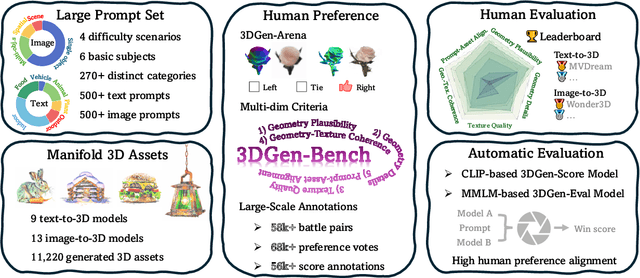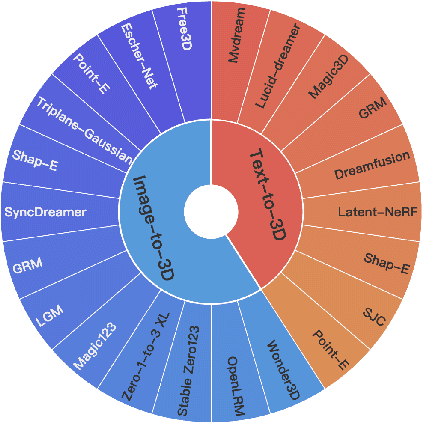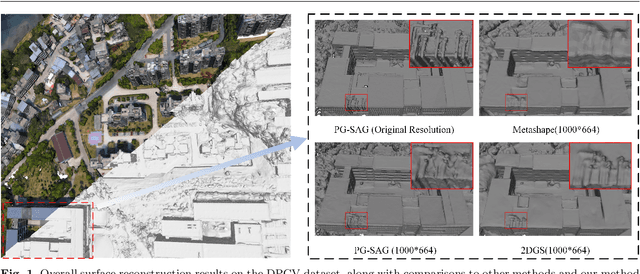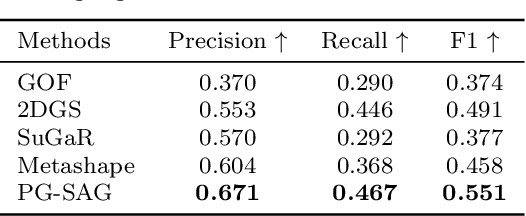Tengfei Wang
HunyuanWorld 1.0: Generating Immersive, Explorable, and Interactive 3D Worlds from Words or Pixels
Jul 29, 2025



Abstract:Creating immersive and playable 3D worlds from texts or images remains a fundamental challenge in computer vision and graphics. Existing world generation approaches typically fall into two categories: video-based methods that offer rich diversity but lack 3D consistency and rendering efficiency, and 3D-based methods that provide geometric consistency but struggle with limited training data and memory-inefficient representations. To address these limitations, we present HunyuanWorld 1.0, a novel framework that combines the best of both worlds for generating immersive, explorable, and interactive 3D scenes from text and image conditions. Our approach features three key advantages: 1) 360{\deg} immersive experiences via panoramic world proxies; 2) mesh export capabilities for seamless compatibility with existing computer graphics pipelines; 3) disentangled object representations for augmented interactivity. The core of our framework is a semantically layered 3D mesh representation that leverages panoramic images as 360{\deg} world proxies for semantic-aware world decomposition and reconstruction, enabling the generation of diverse 3D worlds. Extensive experiments demonstrate that our method achieves state-of-the-art performance in generating coherent, explorable, and interactive 3D worlds while enabling versatile applications in virtual reality, physical simulation, game development, and interactive content creation.
Voyager: Long-Range and World-Consistent Video Diffusion for Explorable 3D Scene Generation
Jun 04, 2025Abstract:Real-world applications like video gaming and virtual reality often demand the ability to model 3D scenes that users can explore along custom camera trajectories. While significant progress has been made in generating 3D objects from text or images, creating long-range, 3D-consistent, explorable 3D scenes remains a complex and challenging problem. In this work, we present Voyager, a novel video diffusion framework that generates world-consistent 3D point-cloud sequences from a single image with user-defined camera path. Unlike existing approaches, Voyager achieves end-to-end scene generation and reconstruction with inherent consistency across frames, eliminating the need for 3D reconstruction pipelines (e.g., structure-from-motion or multi-view stereo). Our method integrates three key components: 1) World-Consistent Video Diffusion: A unified architecture that jointly generates aligned RGB and depth video sequences, conditioned on existing world observation to ensure global coherence 2) Long-Range World Exploration: An efficient world cache with point culling and an auto-regressive inference with smooth video sampling for iterative scene extension with context-aware consistency, and 3) Scalable Data Engine: A video reconstruction pipeline that automates camera pose estimation and metric depth prediction for arbitrary videos, enabling large-scale, diverse training data curation without manual 3D annotations. Collectively, these designs result in a clear improvement over existing methods in visual quality and geometric accuracy, with versatile applications.
3DGen-Bench: Comprehensive Benchmark Suite for 3D Generative Models
Mar 27, 2025



Abstract:3D generation is experiencing rapid advancements, while the development of 3D evaluation has not kept pace. How to keep automatic evaluation equitably aligned with human perception has become a well-recognized challenge. Recent advances in the field of language and image generation have explored human preferences and showcased respectable fitting ability. However, the 3D domain still lacks such a comprehensive preference dataset over generative models. To mitigate this absence, we develop 3DGen-Arena, an integrated platform in a battle manner. Then, we carefully design diverse text and image prompts and leverage the arena platform to gather human preferences from both public users and expert annotators, resulting in a large-scale multi-dimension human preference dataset 3DGen-Bench. Using this dataset, we further train a CLIP-based scoring model, 3DGen-Score, and a MLLM-based automatic evaluator, 3DGen-Eval. These two models innovatively unify the quality evaluation of text-to-3D and image-to-3D generation, and jointly form our automated evaluation system with their respective strengths. Extensive experiments demonstrate the efficacy of our scoring model in predicting human preferences, exhibiting a superior correlation with human ranks compared to existing metrics. We believe that our 3DGen-Bench dataset and automated evaluation system will foster a more equitable evaluation in the field of 3D generation, further promoting the development of 3D generative models and their downstream applications.
GS-I$^{3}$: Gaussian Splatting for Surface Reconstruction from Illumination-Inconsistent Images
Mar 18, 2025Abstract:Accurate geometric surface reconstruction, providing essential environmental information for navigation and manipulation tasks, is critical for enabling robotic self-exploration and interaction. Recently, 3D Gaussian Splatting (3DGS) has gained significant attention in the field of surface reconstruction due to its impressive geometric quality and computational efficiency. While recent relevant advancements in novel view synthesis under inconsistent illumination using 3DGS have shown promise, the challenge of robust surface reconstruction under such conditions is still being explored. To address this challenge, we propose a method called GS-3I. Specifically, to mitigate 3D Gaussian optimization bias caused by underexposed regions in single-view images, based on Convolutional Neural Network (CNN), a tone mapping correction framework is introduced. Furthermore, inconsistent lighting across multi-view images, resulting from variations in camera settings and complex scene illumination, often leads to geometric constraint mismatches and deviations in the reconstructed surface. To overcome this, we propose a normal compensation mechanism that integrates reference normals extracted from single-view image with normals computed from multi-view observations to effectively constrain geometric inconsistencies. Extensive experimental evaluations demonstrate that GS-3I can achieve robust and accurate surface reconstruction across complex illumination scenarios, highlighting its effectiveness and versatility in this critical challenge. https://github.com/TFwang-9527/GS-3I
Gaussian On-the-Fly Splatting: A Progressive Framework for Robust Near Real-Time 3DGS Optimization
Mar 17, 2025Abstract:3D Gaussian Splatting (3DGS) achieves high-fidelity rendering with fast real-time performance, but existing methods rely on offline training after full Structure-from-Motion (SfM) processing. In contrast, this work introduces On-the-Fly GS, a progressive framework enabling near real-time 3DGS optimization during image capture. As each image arrives, its pose and sparse points are updated via on-the-fly SfM, and newly optimized Gaussians are immediately integrated into the 3DGS field. We propose a progressive local optimization strategy to prioritize new images and their neighbors by their corresponding overlapping relationship, allowing the new image and its overlapping images to get more training. To further stabilize training across old and new images, an adaptive learning rate schedule balances the iterations and the learning rate. Moreover, to maintain overall quality of the 3DGS field, an efficient global optimization scheme prevents overfitting to the newly added images. Experiments on multiple benchmark datasets show that our On-the-Fly GS reduces training time significantly, optimizing each new image in seconds with minimal rendering loss, offering the first practical step toward rapid, progressive 3DGS reconstruction.
GS-3I: Gaussian Splatting for Surface Reconstruction from Illumination-Inconsistent Images
Mar 16, 2025Abstract:Accurate geometric surface reconstruction, providing essential environmental information for navigation and manipulation tasks, is critical for enabling robotic self-exploration and interaction. Recently, 3D Gaussian Splatting (3DGS) has gained significant attention in the field of surface reconstruction due to its impressive geometric quality and computational efficiency. While recent relevant advancements in novel view synthesis under inconsistent illumination using 3DGS have shown promise, the challenge of robust surface reconstruction under such conditions is still being explored. To address this challenge, we propose a method called GS-3I. Specifically, to mitigate 3D Gaussian optimization bias caused by underexposed regions in single-view images, based on Convolutional Neural Network (CNN), a tone mapping correction framework is introduced. Furthermore, inconsistent lighting across multi-view images, resulting from variations in camera settings and complex scene illumination, often leads to geometric constraint mismatches and deviations in the reconstructed surface. To overcome this, we propose a normal compensation mechanism that integrates reference normals extracted from single-view image with normals computed from multi-view observations to effectively constrain geometric inconsistencies. Extensive experimental evaluations demonstrate that GS-3I can achieve robust and accurate surface reconstruction across complex illumination scenarios, highlighting its effectiveness and versatility in this critical challenge. https://github.com/TFwang-9527/GS-3I
PG-SAG: Parallel Gaussian Splatting for Fine-Grained Large-Scale Urban Buildings Reconstruction via Semantic-Aware Grouping
Jan 03, 2025



Abstract:3D Gaussian Splatting (3DGS) has emerged as a transformative method in the field of real-time novel synthesis. Based on 3DGS, recent advancements cope with large-scale scenes via spatial-based partition strategy to reduce video memory and optimization time costs. In this work, we introduce a parallel Gaussian splatting method, termed PG-SAG, which fully exploits semantic cues for both partitioning and Gaussian kernel optimization, enabling fine-grained building surface reconstruction of large-scale urban areas without downsampling the original image resolution. First, the Cross-modal model - Language Segment Anything is leveraged to segment building masks. Then, the segmented building regions is grouped into sub-regions according to the visibility check across registered images. The Gaussian kernels for these sub-regions are optimized in parallel with masked pixels. In addition, the normal loss is re-formulated for the detected edges of masks to alleviate the ambiguities in normal vectors on edges. Finally, to improve the optimization of 3D Gaussians, we introduce a gradient-constrained balance-load loss that accounts for the complexity of the corresponding scenes, effectively minimizing the thread waiting time in the pixel-parallel rendering stage as well as the reconstruction lost. Extensive experiments are tested on various urban datasets, the results demonstrated the superior performance of our PG-SAG on building surface reconstruction, compared to several state-of-the-art 3DGS-based methods. Project Web:https://github.com/TFWang-9527/PG-SAG.
Neural LightRig: Unlocking Accurate Object Normal and Material Estimation with Multi-Light Diffusion
Dec 12, 2024



Abstract:Recovering the geometry and materials of objects from a single image is challenging due to its under-constrained nature. In this paper, we present Neural LightRig, a novel framework that boosts intrinsic estimation by leveraging auxiliary multi-lighting conditions from 2D diffusion priors. Specifically, 1) we first leverage illumination priors from large-scale diffusion models to build our multi-light diffusion model on a synthetic relighting dataset with dedicated designs. This diffusion model generates multiple consistent images, each illuminated by point light sources in different directions. 2) By using these varied lighting images to reduce estimation uncertainty, we train a large G-buffer model with a U-Net backbone to accurately predict surface normals and materials. Extensive experiments validate that our approach significantly outperforms state-of-the-art methods, enabling accurate surface normal and PBR material estimation with vivid relighting effects. Code and dataset are available on our project page at https://projects.zxhezexin.com/neural-lightrig.
SAR3D: Autoregressive 3D Object Generation and Understanding via Multi-scale 3D VQVAE
Nov 25, 2024Abstract:Autoregressive models have demonstrated remarkable success across various fields, from large language models (LLMs) to large multimodal models (LMMs) and 2D content generation, moving closer to artificial general intelligence (AGI). Despite these advances, applying autoregressive approaches to 3D object generation and understanding remains largely unexplored. This paper introduces Scale AutoRegressive 3D (SAR3D), a novel framework that leverages a multi-scale 3D vector-quantized variational autoencoder (VQVAE) to tokenize 3D objects for efficient autoregressive generation and detailed understanding. By predicting the next scale in a multi-scale latent representation instead of the next single token, SAR3D reduces generation time significantly, achieving fast 3D object generation in just 0.82 seconds on an A6000 GPU. Additionally, given the tokens enriched with hierarchical 3D-aware information, we finetune a pretrained LLM on them, enabling multimodal comprehension of 3D content. Our experiments show that SAR3D surpasses current 3D generation methods in both speed and quality and allows LLMs to interpret and caption 3D models comprehensively.
Material Anything: Generating Materials for Any 3D Object via Diffusion
Nov 22, 2024



Abstract:We present Material Anything, a fully-automated, unified diffusion framework designed to generate physically-based materials for 3D objects. Unlike existing methods that rely on complex pipelines or case-specific optimizations, Material Anything offers a robust, end-to-end solution adaptable to objects under diverse lighting conditions. Our approach leverages a pre-trained image diffusion model, enhanced with a triple-head architecture and rendering loss to improve stability and material quality. Additionally, we introduce confidence masks as a dynamic switcher within the diffusion model, enabling it to effectively handle both textured and texture-less objects across varying lighting conditions. By employing a progressive material generation strategy guided by these confidence masks, along with a UV-space material refiner, our method ensures consistent, UV-ready material outputs. Extensive experiments demonstrate our approach outperforms existing methods across a wide range of object categories and lighting conditions.
 Add to Chrome
Add to Chrome Add to Firefox
Add to Firefox Add to Edge
Add to Edge